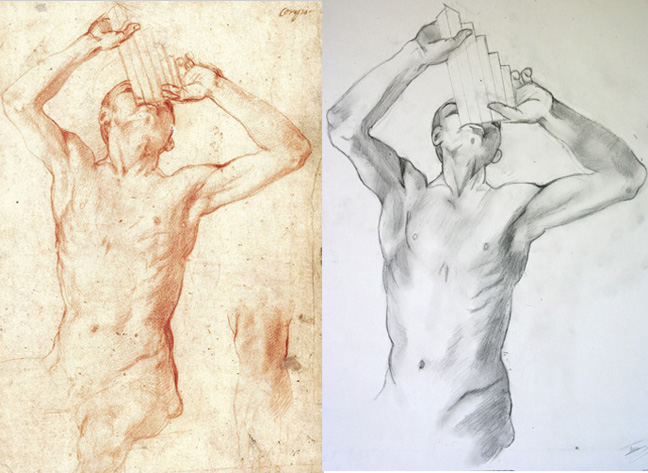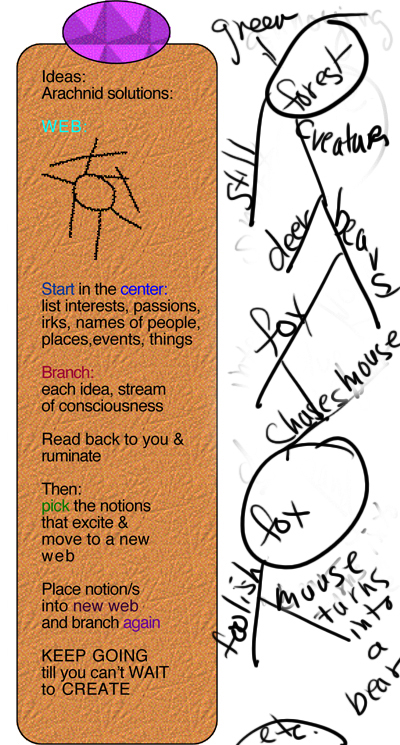Practical Inspiration means keeping an Inspiration folder.
I keep one on my computer desktop AND one in my studio. A folder full of images that catch my eye.
Some are works of art that I wish I had made;)
Some are works of art that I find interesting but are VERY different from the art I make.
Some are snatches of textures, examples of color palettes or examples of unusual shapes.
Some are visual puns.
Some are works made from materials that I have never tried to use.
Some are examples of great concepts.
Some are images for reference.
Practical inspiration means learning from great artists.
Below is a drawing “copied” in the very best sense possible, by Andrew. This piece was an exercise in direct observation of a masterwork by Bronzino. When asked what he learned making this drawing, Andrew offered that he paid attention to the quality of the line, especially the way in which it breaks, is strong in places and subtle in other places. Andrew also commented that he learned a different way to approach shading.
Practical inspiration means concrete advice about how to get your creativity rolling.
Here’s one great example:
Keeping a sketchbook can be an excellent way to work through concepts and generate ideas for your work.
This set of bookmarks is designed especially for slipping into your sketchbook for instant reference.
They all fit together with a staple or a fastener through the button at the top. The suggestions and questions come from my experience, and from the collective wisdom of other artists. Feel free to print them*, put them together and carry them in YOUR sketchbook.
1. Cover-so you can email me with questions.

2.
Dress up those blank white pages before you draw on them.
have fun with wet into wet watercolor or sprinkle some salt onto wet dark hues
paste some text on another page, play with scale
got scrap paper? cut or tear paper shapes & paste onto another page and/or create overall patterns within the negative space
find an object in a room and contour the negative space, again & again, overlapping the images
tissue makes a great textured surface to work over
drag around a blob of acrylic paint with old combs, old credit cards, etc. & you’ll see all sorts of possibilities to draw into
collage one or two images, what will you add later?
ask a friend to have at it, then add your own work
play with plain old stamps from any craft store or from discarded envelopes, draw a story around them
paste or fit a 3-d object on a page, what can you make it into now?
cover a page with pencil writing then paint over or into it-what will you say?
stipple or dot up a page & connect them later
place some masking tape on a page, paint over it & then remove the tape-rips are wonderful
find only one image from a magazine & paste it in the middle of a page-draw a story around it
go ahead & just scribble & doodle-these pages can stand alone or create interesting textures for work on top of them.
EXPERIMENT!
3.
More ways to get some ideas going…..
make it a ritual to really observe & study one thing every day-a creature one day, a shadow the next , & so on
ask a friend to draw 5 lines on a page-make something out of them
visual stim can be anything you take the time to look at and marvel over
I’ll talk about Betty Edwards “emotion palette” in another post
walk around your house & pretend you are shopping, pick up 3 objects, put them together and draw them
best times to think about new projects or to troubleshoot a project in progress
day-dream every chance you get
take some time alone & make yourself think about this list:walk around your room with your eyes closed & pick up three objects-now open your eye & draw them but…push them by exaggerating scale perspective, cropping, perception
grab a camera, hold it over your head and shoot-click, behind your back click, and so on…
improvise on any or all of the suggestions above
4.This is pretty clear-MORE ideas  5.
5.
For some artists, thinking in words
helps to generate ideas. Others proceed
directly to sketches. Try this, and see what works best for you.
6. OK, now that you have an idea, ask yourself the questions contained in
bookmark 6. These questions will (annoyingly) help you to challenge
yourself.
Think about expanding your media choices….and have fun.
Practical inspiration is a new method or approach.
My very basic, very practical, handy dandy formula for beginning a portrait in pencil:
So much of rendering a likeness in a portrait is getting the spacing between features, and the shapes of features, smack on. Rendering the values correctly is another important part of the process. The formula below is one way to break down the process so you can concentrate on one part at a time.
Getting a “likeness” in a portrait.
——————————————————————————————————————
*YOUR ARE WELCOME TO PRINT AND USE ALL OF THE MATERIAL ON THIS PAGE FOR YOUR OWN WORK, OR AS A TEACHING AID HOWEVER, PLEASE TO NOT REPRODUCE, COPY OR DISTRIBUTE IN ANY PART OR ANY FORM FOR ANY OTHER PURPOSE WITHOUT EXPRESS PERMISSION. ALL RIGHTS RESERVED, ELENA CARAVELA 2011
Thank you!







I’m always interested in learning more about art and other ways to be inspired. I found this to be very helpful. Thank you for this post.
You are so very welcome!
Great post!
Thank you!
Hi Elena, Finally catching up on some of your previous blogs. I thought your portrait was EX-tremely successful! And I really appreciate what you shared here. You are so gifted — thanks for sharing this info with everyone!! 🙂
Kathy
Thank you Kathy, much appreciated.